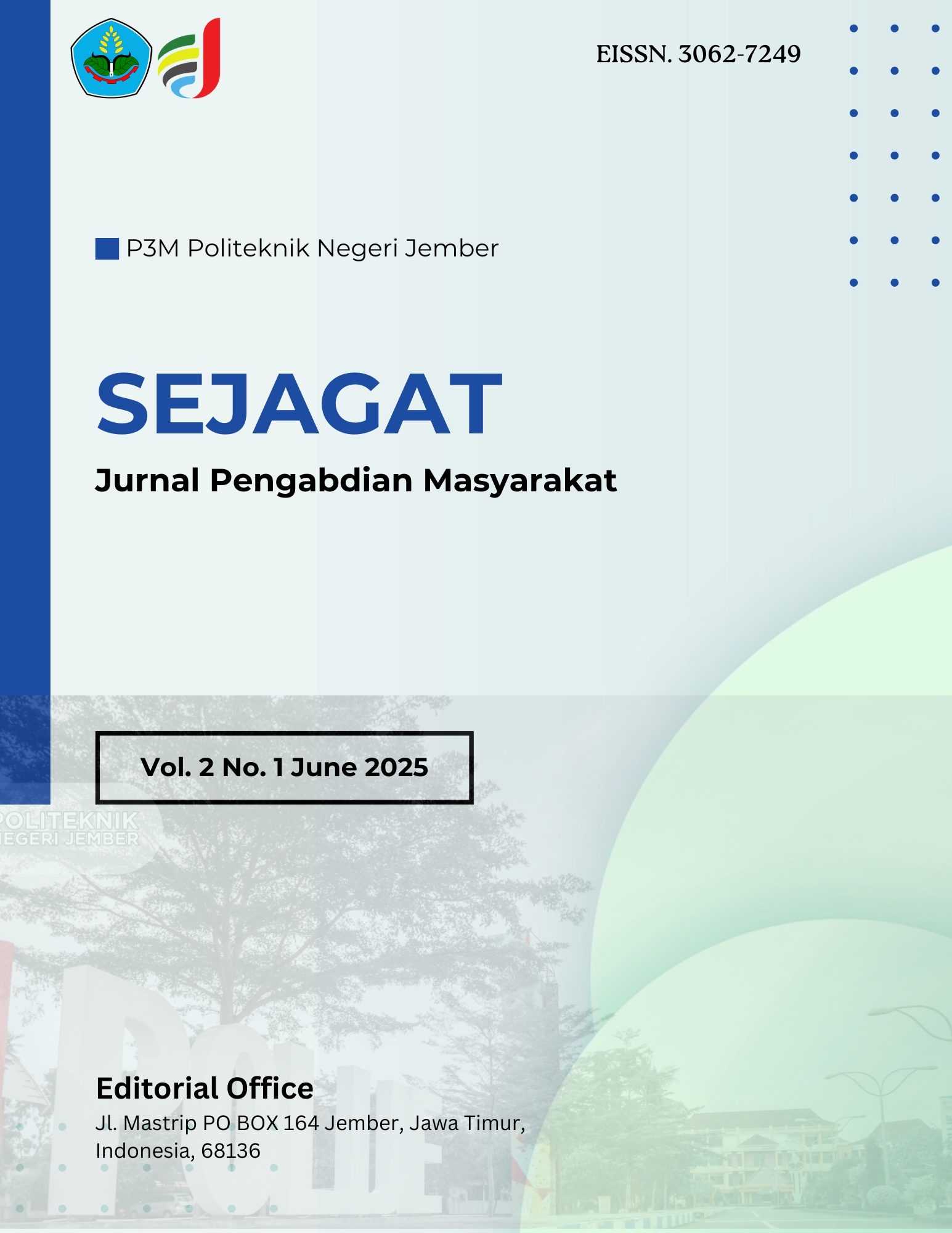Upaya Peningkatan Pengetahuan Remaja Tentang Anemia Gizi Besi di SMPN 1 Yosowilangun
DOI:
https://doi.org/10.25047/sejagat.v2i1.5721Keywords:
Effort, Knowledge, Adolescent, Iron Nutrition AnemiaAbstract
Iron Nutrition Anemia is a condition of blood hemoglobin deficiency that can reduce productivity and affect the cognitive development of adolescents. Adolescent girls are susceptible to anemia due to several causal factors. There is an increased need for iron during puberty. Another factor that causes anemia is low consumption of Fe and other nutrients such as vitamin A, vitamin C, folic acid, riboflavin, and B12. This community service activity aims to increase adolescents' knowledge about AGB through educational programs at SMPN 1 Yosowilangun, Lumajang Regency. The activity was carried out in August 2024 and involved 30 teenagers in the 3rd grade of junior high school. The methods used included discourse and discussions supported by presentation media, leaflets, and the Freemia website. Through this activity, we hope to enhance teenagers' understanding of anemia risks, the significance of iron intake, and the importance of adopting a healthy diet to prevent anemia. Health education in schools is expected to be a strategic step in reducing the incidence of anemia in adolescents in Indonesia.
References
[1] Novy Ramini Harahap, “Faktor-faktor yang Berhubungan dengan Kejadian Anemia Pda Remaja Putri,” Nurs. Arts, vol. 12, no. 2, pp. 78–90, 2018.
[2] WHO, Worldwide Prevalence of Anaemia 1993-2020: A Global Database of Anaemia. Geneva: World Health Organization, 2020.
[3] M. Kaur, R. Bassi, and S. Sharma, “Impact of Nutrition Education in Reducing Iron Deficiency Anemia in Adolescent Girls,” Indian J. Fundam. Appl. Life Sci., vol. 1, no. 4, pp. 222–228, 2011.
[4] Balitbangkes, Laporan Hasil Riset Kesehatan Dasar Tahun 2018. Jakarta: Balai Penelitian dan Pengembangan Kesehatan Republik Indonesia, 2019.
[5] A. H. S. Putri, “Analisis Pelaksanaan Program Pemberian Tablet Tambah Darah Pada Remaja Putri Di Wilayah Kerja Puskesmas Candipuro Kabupaten Lumajang Tahun 2019,” Politeknik Negeri Jember, 2021.
[6] A. Al-Jawaldeh et al., “Are Countries of the Eastern Mediterranean Region on Track towards Meeting the World Health Assembly Target for Anemia? A Review of Evidence,” Int J Env. Res Public Heal., vol. 18, no. 5, p. 2449, 2021, doi: 10.3390/ijerph18052449.
[7] Julaecha, “Upaya Pencegahan Anemia pada Remaja Putri,” J. Abdimas Kesehat., vol. 2, no. 2, p. 209, 2020, doi: 10.36565/jak.v2i2.105.
[8] B. N. Pangaribuan et al., “Studi Literatur tentang Hubungan Tingkat Pengetahuan dengan Kejadian Anemia Pada Remaja Putri di Beberapa Wilayah Indonesia,” Manuju Malahayati Nurs. J., vol. 4, no. 6, pp. 1378–1386, 2022.
[9] K. Permanasari, Jannaim, and Y. S. Wati, “Hubungan Pengetahuan Tentang Anemia Dengan Kadar Hemoglobin Remaja Putri di SMAN 05 Pekanbaru,” Dunia Keperawatan J. Keperawatan dan Kesehat., vol. 8, no. 2, p. 313, 2020, doi: 10.20527/dk.v8i2.8149.
[10] Martini, “Faktor - Faktor Yang Berhubungan Dengan Kejadian Anemia Pada Remaja Putri Di Man 1 Metro,” J. Kesehat. Metro Sai Wawai, vol. VIII, no. 1, pp. 1–7, 2015.
[11] H. P. Putri, F. Andara, and D. L. Sufyan, “Pengaruh Edukasi Gizi Berbasis Video Terhadap Peningkatan Pengetahuan Remaja Putri di Jakarta Timur,” J. Bakti Masy. Indones., vol. 4, no. 2, pp. 334–342, 2021.
Downloads
Published
How to Cite
Issue
Section
License
Copyright (c) 2025 Sabran, Dian Kartika Sari, Iwan Abdi Suandana, Malinda Capri Nurul Satya

This work is licensed under a Creative Commons Attribution-ShareAlike 4.0 International License.




